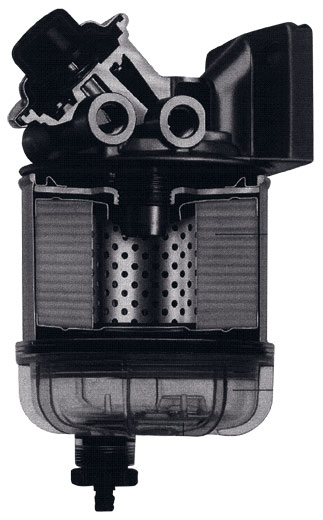Motor
-
See advice
The flaps or trim stabilisers, permit, by modifying the hydraulic flux to the rear of the hull, improvement in the boats behaviour, control and manoeuvrability. By reducing friction whilst augmenting the speed of the boat, you reduce also your fuel consumption.
For the choice of the characteristics of the flaps, you must consider:
-The size of the boat. The larger the boat, the longer the flaps.
-The weight of the boat. The heavier the boat is, the greater the surface of the flaps should be.
-The width of the transom.
-The position of the strakes.
-The type of motorisation (Z-drive, shaft, propeller surface …)
In general, one should choose the greatest width except when the motor or position of the strakes prohibit.The flaps do not require special maintenance (except antifouling). It may require anodes in the case of boats very sensitive to electrolysis (a hole is pre-drilled on the flaps.) -
See advice
Long life for your motor
The filter/separators that we suggest, separate the solid particles contained in the fuel by a centrifugal action, these particles fall to the bottom and the cartridge then filters out the last remaining drops of water and extremely fine matter. The advantages of such a filter are that it permits no particles of water or solids to pass through. It is mounted between the tank and the motor, which allows it to be changed without having to readjust the engine and finally, if it is saturated, it will not permit the passage of water. In this situation, the system is drained and the engine stopped without any damage. The smallest model is designed for a maximum flow of 57 l / h. This may seem excessive on a sail boat, but rest assured what can do more can cope with less.
-
See advice
Removing the old foam
Replacing the foam in the motor compartment is not a pleasant task. The old kind was difficult to remove (often soaked in oil,) necessitating the dismantling of certain equipment (electrical wire, filter, pump…) attached to the wall in order to prepare the surface. Not technically difficult this task is within the reach of any boater who has free time and is not afraid to slip into the engine compartment. If your boat is older than 15years, there is a strong chance that it is equipped with convoluted foam which lacks efficiency concerning low frequencies, such as diesel engines; this only worsens as it gets older. You may also have flat, lightweight foam, a little more efficient on low frequencies, but whose main plus is to be easier to clean. On more modern boats, it really depends on where they were made, or the range of boat, wheteher they have the worst (convoluted lightweight foam,) or the b -
See advice
Outboard motors
The proper use
Once the engine is started it is necessary to check that the cooling pump works well (water jet to the rear of the motor.)One should not turn it out of the water. Whentransporting, it should never be placed upside down. Always take quality marine oil both for 2-stroke or 4-stroke engines.
Wintering and maintaining an outboard motor
On an outboard motor, there is little maintenance. However, the water system must be rinsed and the oil changed (4-stroke motor.)The base (2 and 4 stroke,)is filled with a special oil and this must be changed once per year (the change permits checking the water has not entered the base, in -
See advice
Make the right choice
You can not judge the quality of an anode according to its appearance. On the market, one finds the worst and the best. To ensure maximum protection, the zinc must be composed of a minimum purity of 99.996% and have an iron content of less than 0.0014%. If zinc is the most commonly used, there are also specific aluminum anodes for outboard engines or in Hydral (an alloy of aluminum and magnesium) for aluminum boats.Different Anodes for different surfaces
On polyester boats equipped with an inboard motor, the points to protect are the shaft or motor base, the propeller and bracket and eventually the chair fittings. On a stainless steel hull, one places the anodes close to the
